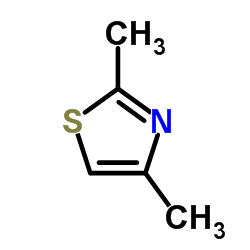2.4-Dimethyl thiazole

2.4-Dimethyl thiazole structure
|
Common Name | 2.4-Dimethyl thiazole | ||
|---|---|---|---|---|
| CAS Number | 541-58-2 | Molecular Weight | 113.181 | |
| Density | 1.1±0.1 g/cm3 | Boiling Point | 153.4±9.0 °C at 760 mmHg | |
| Molecular Formula | C5H7NS | Melting Point | N/A | |
| MSDS | Chinese USA | Flash Point | 46.0±7.6 °C | |
| Symbol |


GHS02, GHS07 |
Signal Word | Warning | |
|
Sclerotium rolfsii lectin induces stronger inhibition of proliferation in human breast cancer cells than normal human mammary epithelial cells by induction of cell apoptosis.
PLoS ONE 9(11) , e110107, (2014) Sclerotium rolfsii lectin (SRL) isolated from the phytopathogenic fungus Sclerotium rolfsii has exquisite binding specificity towards O-linked, Thomsen-Freidenreich (Galβ1-3GalNAcα1-Ser/Thr, TF) associated glycans. This study investigated the influence of SRL... |
|
|
Cell-penetrating antimicrobial peptides - prospectives for targeting intracellular infections.
Pharm. Res. 32(5) , 1546-56, (2015) To investigate the suitability of three antimicrobial peptides (AMPs) as cell-penetrating antimicrobial peptides.Cellular uptake of three AMPs (PK-12-KKP, SA-3 and TPk) and a cell-penetrating peptide (penetratin), all 5(6)-carboxytetramethylrhodamine-labeled,... |
|
|
HGUE-C-1 is an atypical and novel colon carcinoma cell line.
BMC Cancer 15 , 240, (2015) Colorectal carcinoma is a common cause of cancer. Adjuvant treatments include: 5-fluorouracil administered together with folinic acid, or more recently, oral fluoropyrimidines such as capecitabine, in combination with oxaliplatin or irinotecan. Metastatic col... |
|
|
Osteotropic polypeptide nanoparticles with dual hydroxyapatite binding properties and controlled cisplatin delivery.
Pharm. Res. 32(5) , 1794-803, (2015) Nanoparticles with prolonged residence time in bone constitute a valuable strategy for bone disease treatments. The aim of this work was to synthesise a simple nanoparticulate system exhibiting both anticancer and hydroxyapatite binding properties for potenti... |
|
|
Fluorescent magnetic iron oxide nanoparticles for cardiac precursor cell selection from stromal vascular fraction and optimization for magnetic resonance imaging.
Int. J. Nanomedicine 10 , 711-26, (2015) Fluorescent magnetic iron oxide nanoparticles have been used to label cells for imaging as well as for therapeutic purposes. The purpose of this study was to modify the approach to develop a nanoprobe for cell selection and imaging with a direct therapeutic t... |
|
|
Self-assembled polymeric nanoparticles as new, smart contrast agents for cancer early detection using magnetic resonance imaging.
Int. J. Nanomedicine 10 , 63-76, (2015) Early cancer detection is a major factor in the reduction of mortality and cancer management cost. Here we developed a smart and targeted micelle-based contrast agent for magnetic resonance imaging (MRI), able to turn on its imaging capability in the presence... |
|
|
Nitric oxide-releasing poly(lactic-co-glycolic acid)-polyethylenimine nanoparticles for prolonged nitric oxide release, antibacterial efficacy, and in vivo wound healing activity.
Int. J. Nanomedicine 10 , 3065-80, (2015) Nitric oxide (NO)-releasing nanoparticles (NPs) have emerged as a wound healing enhancer and a novel antibacterial agent that can circumvent antibiotic resistance. However, the NO release from NPs over extended periods of time is still inadequate for clinical... |
|
|
In vitro comparison of commercial oral rinses on bacterial adhesion and their detachment from biofilm formed on hydroxyapatite disks.
Oral Health Prev. Dent. 12(4) , 365-71, (2014) This in vitro study was designed to assess the effectiveness of three oral rinses on bacterial adherence to epithelial cells and hydroxyapatite surfaces. The role of oral rinses on the detachment of bacteria from biofilm was also evaluated.The efficacy of thr... |
|
|
AG4, a compound isolated from Radix Ardisiae Gigantifoliae, induces apoptosis in human nasopharyngeal cancer CNE cells through intrinsic and extrinsic apoptosis pathways.
Anticancer Drugs 26(3) , 331-42, (2015) 3β-O-{α-L-Pyran rhamnose-(1→3)-[β-D-xylopyranose-(1→2)]-β-D-glucopyranose-(1→4)-[β-D-lucopyranose-(1→2)]-α-L-pyran arabinose}-cyclamiretin A (AG4) is a saponin component obtained from the Giantleaf Ardisia Rhizome (Rhizoma Ardisiae Gigantifoliae). The present... |
|
|
The small molecule tyrosine kinase inhibitor NVP-BHG712 antagonizes ABCC10-mediated paclitaxel resistance: a preclinical and pharmacokinetic study.
Oncotarget 6(1) , 510-21, (2015) Paclitaxel exhibits clinical activity against a wide variety of solid tumors. However, resistance to paclitaxel significantly attenuates the response to chemotherapy. The ABC transporter subfamily C member 10 (ABCC10), also known as multi-drug resistance prot... |